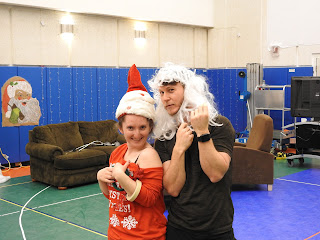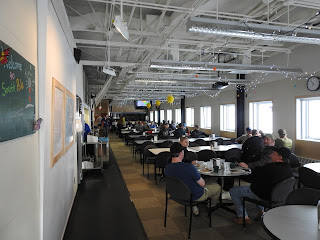Normally we work 6 days a week, more or less, except on holidays where we get an extra day off. As a scientist, my schedule is a little more flexible. Some days, I only have a few hours of work here and there. Other days I may be up very early or very late fixing problems. Last week we actually had a couple of issues. One of our servers died at 3:30 in the morning. For some of our servers this is not a big deal, and we can take care of it the next day. Unfortunately, this one was a DOMHub which means it is really important, and we had to deal with it immediately. My colleague Martin was on call, so he went out to the ICL (IceCube Lab) to fix it, while I monitored things from station. It turns out things were a little worse than we suspected so I ended up heading out as well to help him get things running again. After a few hours we got it all taken care of, and then came back for breakfast followed by a short nap before getting started on the rest of our TODO list for the day. Then, two days later, there was another failure, this time around 7 in the morning. This time I had to get up and head out to fix the problem. This involves getting all dressed up in cold weather gear and either walking or thankfully in the summer riding out on snowmobile. It was a quicker fix this time, and thankfully the last of our problems for a while.
The Thursday before Christmas we had another exciting task. A few times a year, we have to go out and measure the snow accumulation on parts of the detector. This is roughly 80 pairs of tanks, each of which gets measures spread out over a square kilometer. We were able to use one of the Piston Bullies (pictured below) to drive around to the tanks. This gave us a few minutes of warmth between measurements. Overall, this took us about a day of work. Fortunately, we had a little help from a summer IceCube visitor, Gwen.
Finally, on Christmas eve we had a ton of things going on here on station. The first big thing is the station Christmas dinner. We had beef Wellington and stuff lobster tails with all sorts of European deserts. After this there was a big Christmas party with a live band dancing and socializing. Sadly, in setting up for the party, I smashed my thumb between a couch and a door, and now my thumbnail is still blue! Ah, how difficult life is here at the South Pole!
Overall the past couple of weeks have been really good. I do miss my family here. I don't get to talk to them much due to limited satellite access and different time zones, but as I think I have said in the past, I am very fortunate to be able to work with such a great group of people here at the South Pole and in the IceCube collaboration. I feel like the work I am doing is very rewarding. I am excited about the science that IceCube and the IceCube collaboration are doing. On top of that, every so often I stop and think, "Holy crap, I am at the South Pole!" I am looking forward to continuing this work for the next year and seeing what the Antarctic Winter holds for us! I hope you enjoy some of the pictures below.
I finally made it out to the Ham radio rig at the South Pole. Usually you access it remotely from the station, but it is nice to know where the actual hardware is in case I have to fix something.
Our trusty Piston Bully!
Martin and Gwen measuring snow buildup on the IceTop Tanks.
We found this makeshift Christmas tree out near the materials area of the station on the way back from measuring snow. It is mostly made of cargo straps!
Our station doctor poses with our party coordinator. They are really getting into the Christmas spirit.
I brought a bunch of the Christmas cards I received from the students at Whitesburg Christian Academy to our party, and some of the people really appreciated reading them!
What Christmas would be complete without cheesy Christmas movies?
Everyone gathered on Christmas Eve for an amazing dinner!
Desserts!
Martin and I even got presents from the IceCube back in Madison, WI. Thanks everyone!
We wrapped the evening up with a party in the gym. It was a great Christmas!









































